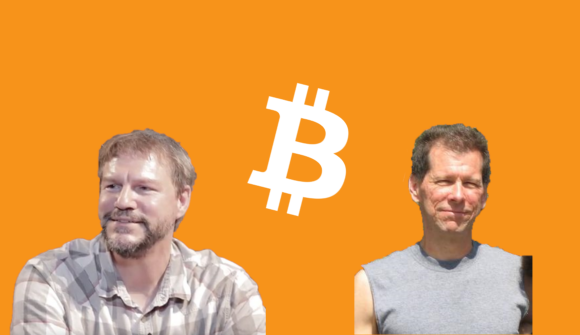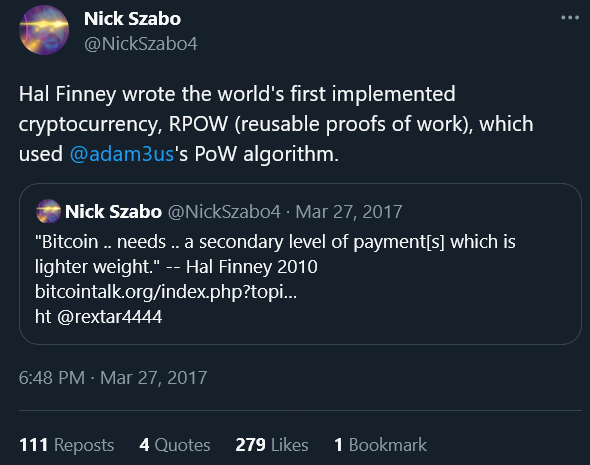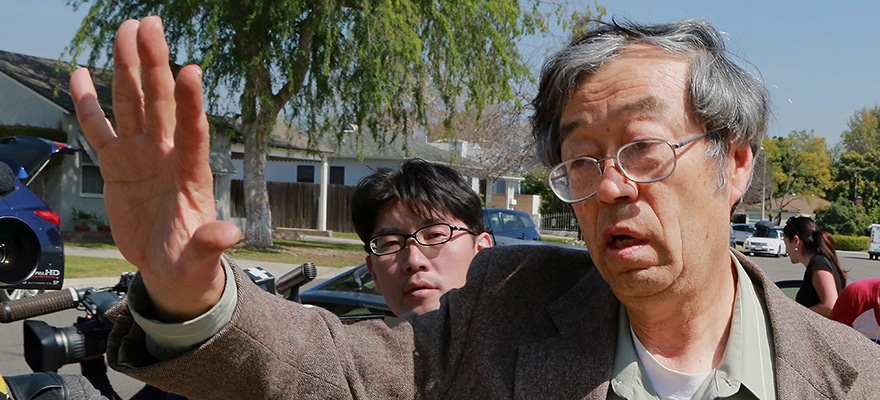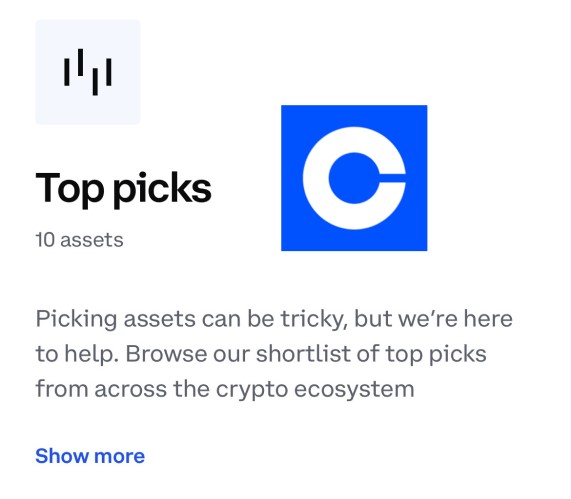Evaluating the Theory Behind Hal Finney Helping Nick Szabo Create Bitcoin

Bitcoin's creation is a mystery that most people deem impossible to solve. Satoshi Nakamoto, the pseudonymous creator of Bitcoin, has been purported to be a number of different people. Despite this daunting challenge, I have conducted extensive research, reaching the conclusion that the key person in the Satoshi vehicle was computer scientist Nick Szabo.
In my research, I discovered that the timing and circumstantial evidence for Mr Szabo was remarkable. Szabo pioneered smart contracts, a crucial concept for Bitcoin Script. Also, Szabo's first digital cash design drafted in 1998, Bit gold, was never cited in the whitepaper, despite sharing uncanny similarities with Bitcoin.
Additionally, Szabo used the terms "miners" in Bit gold before Satoshi and even refers to Bit gold as Bitcoin's "predecessor design." Top Satoshi Nakamoto researchers Dominic Frisby and Nathaniel Popper reached the same conclusion as I. Jeff Roberts, a respected finance journalist, also agrees, discussing in a 2017 Fortune piece how insiders he privately spoke to were convinced it was Szabo.
Although, it has often been suggested by many that the creation of Bitcoin was too difficult for one person to single-handedly do. So, assuming Szabo was a key figure involved, it is possible he may have had help in other ways behind-the-scenes. Today, I will explain the circumstantial evidence often associated with Hal Finney assisting Nick Szabo with Bitcoin's creation and whether the theory holds water or not.
Finney and Szabo were good friends
In life, most people typically acquire friends based on common interest and location. It appears that it was no different with Hal Finney and Nick Szabo. By all accounts, they met in California via a shared interest in extropy, then joined the cypherpunk movement during during its earliest days.
Cypherpunks are computer programmers who work to put the power of secure and private communication back in the hands of the public. The pair of friends were arguably the most prominent cypherpunks besides Julian Assange.
Their friendship is further supported by Hal Finney being a recipient on Szabo's now famous 1998 private email list called "Libtech." Along with Finney, Wei Dai, Tim May, and economists George Selgin and Larry White were the other known recipients. Szabo released Bit gold there for the first time, and this is also where Wei Dai released B-money.
Finney being the second user of Bitcoin is convenient
Hal Finney participated from the start using his public identity, so this could have been planned by himself and Szabo for various reasons. Since Finney participated using his real name, he was still able to help Satoshi publicly while collaborating with other core developers at the same time.
It is public knowledge that Finney was the second ever user of Bitcoin, with Satoshi sending him 10 Bitcoin in the first transaction. Satoshi's early public communications with Finney also come across as scripted to some people.
Given their previous relations, it seems possible that Satoshi conducted this risky transaction with Finney because Szabo would trust him - meaning it could have all been planned from the start. This trust is further shown in a statement made by Satoshi himself. In response to Finney complimenting Satoshi on his code, Satoshi replied:
"That means a lot coming from you Hal. Thanks."
Szabo and Finney collaborated on Bit gold
Nick Szabo spent many years working on Bit gold, as revealed in his 2019 interview with Peter McCormack. Although, it is crystal clear that Hal Finney was right along with him, working to make Bit gold a reality, which soon came to be, in the form of an important precursor to Bitcoin.
Szabo stated numerous times in the years leading up to Bitcoin that Hal Finney had successfully implemented a variant of Bit gold known as RPOW. The project simply would have never been a reality without help from Szabo.

In fact, RPOW was so close to being a massive success, that Szabo labeled it the "world's first implemented cryptocurrency." Strangely, neither project was cited in the Bitcoin whitepaper, despite both being far more relevant to Bitcoin's design than B-money.
They both even used Adam Back's Hashcash and open source databases featuring shared ownership records implemented through public key cryptography.
So, if RPOW was the first implemented cryptocurrency, then why didn't Satoshi cite it in the whitepaper? Because, just like Bit gold, it could theoretically place far too much scrutiny on Szabo and Finney.

Dorian Nakamoto connection
Many in the crypto world wonder why Bitcoin's mysterious creator chose the pseudonym "Satoshi Nakamoto." Well, in 2014 after some digging by various journalists, that question may have been partially answered.
It was revealed that a retired government programmer named Satoshi Nakamoto lived mere miles away from Hal Finney. The Japanese-American man was famously pinned by Newsweek journalist Leah Goodman as Bitcoin's creator, but it became apparent quickly that they were not the same person. This whole situation seemed like a crazy coincidence, or was it?
Hal Finney lived so close to Nakamoto, that it was discovered they went to the same high school. Given that Nick Szabo lived in the same state as both men and was friends with Finney, several assumptions could be drawn. Since Hal Finney always supported Nick Szabo publicly in his works, it would be effortless for him to provide Szabo with a pseudonym of a man who lived just down the road.
Despite Finney denying that he ever knew Dorian, it would have been effortless for Finney to find his name in a phone book and send it to Nick Szabo. That way, if either man were suspected to be Satoshi, it would make it look like Dorian was the creator of Bitcoin, which is what actually transpired for a few years.
It is also worth noting that Szabo could have thought of this strategy himself without any help from Finney.

Why Finney was not behind the code or writings
In 2014, an ambitious journalist named Andy Greenberg embarked on a journey to find the creator of Bitcoin. His research initially led him to Hal Finney after confirming for himself that Dorian Nakamoto was not Satoshi. Greenberg knew about Finney's PGP work and found it odd, like others before him, that Finney lived so close to Dorian Nakamoto.
Although, after doing the last ever interview with Hal Finney before his tragic death due to ALS, Greenberg came to the conclusion that Finney was not Satoshi Nakamoto after all. Part of his conclusion involved Finney's denial, but more importantly, there was one crucial detail revealed by Finney that made it impossible for him to be behind the writings and code: he predominantly used a Mac.
Satoshi Nakamoto was not a Mac user, explaining on many occasions that he had no experience using them; asking other core developers to create the Mac versions of the software. This automatically rules out Finney as being behind the code and writings.
Simply put, Satoshi was conducting his Bitcoin work on an Windows computer, while occasionally using Linux. Furthermore, Dominic Frisby revealed in his excellent book, Bitcoin: The Future of Money?, that Nick Szabo was a Windows user in the 2000s, which was Satoshi's preferred operating system.
Arguments against this theory
The goal of this article is to examine the strength of available evidence behind the theory of Hal Finney helping Nick Szabo create Bitcoin. As such, there are valid arguments against this theory being true. One reason is that even circumstantial evidence can be weak or strong depending on its content, and the evidence here should not be viewed as strong.
Also, an important message written by Finney one week after the whitepaper's release (covered in my Szabo-Satoshi article) casts doubt on Finney helping Satoshi behind the scenes.
Specifically, Finney told Satoshi:
"Nick Szabo wrote many years ago about what he called bit gold and this could be an implementation of that concept."
This would be an incredibly odd thing for Finney to say to Satoshi if he was helping Nick Szabo create Bitcoin behind the scenes. Indeed, Finney's message seems to strongly imply that he truly did not know who Satoshi was 1 week after the whitepaper — a narrative which Finney reiterated in his heartfelt farewell message on the Bitcoin forum.
Conclusion
My research points in the direction of Nick Szabo possibly being Satoshi, but parts of the journey are argued as difficult by some without behind-the-scenes help. Based on Finney being the second Bitcoin user, their friendship/Bit gold collaboration, and coincidences with Dorian Nakamoto, it is a somewhat reasonable theory that Finney helped Szabo create Bitcoin at first glance.
Although, Szabo does appear to possess the intellect to have done it himself. Ultimately, the available data indicates that Satoshi was most likely one person with possible assistance from people in his inner circle. In the end, the evidence leads in the direction of Finney likely not knowing anything about Satoshi or his background.
* Disclaimer: This article is based on extensive research using public resources. The conclusions reached by the author are opinions, not established facts. Readers should evaluate the material independently.




